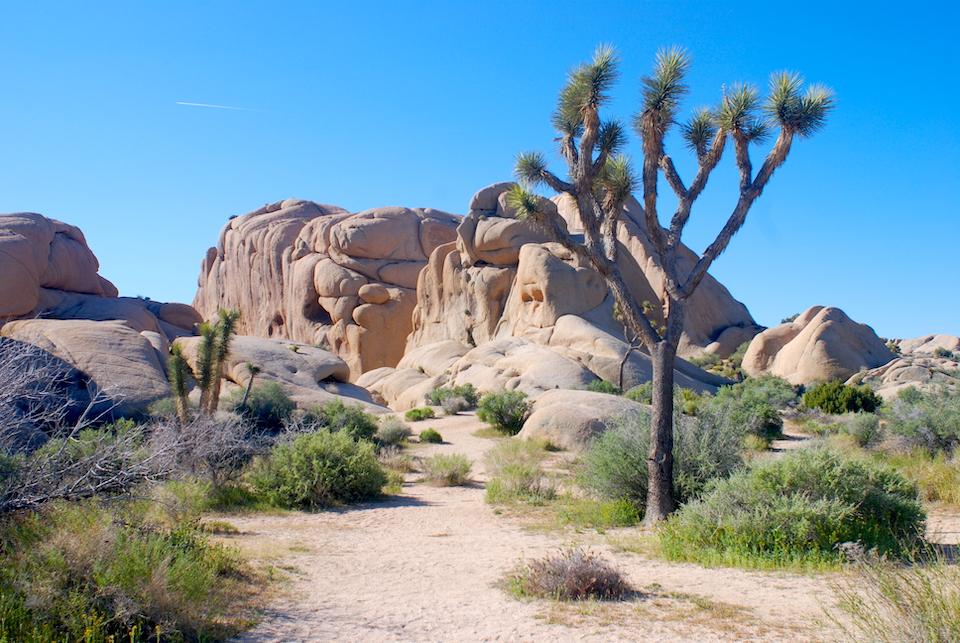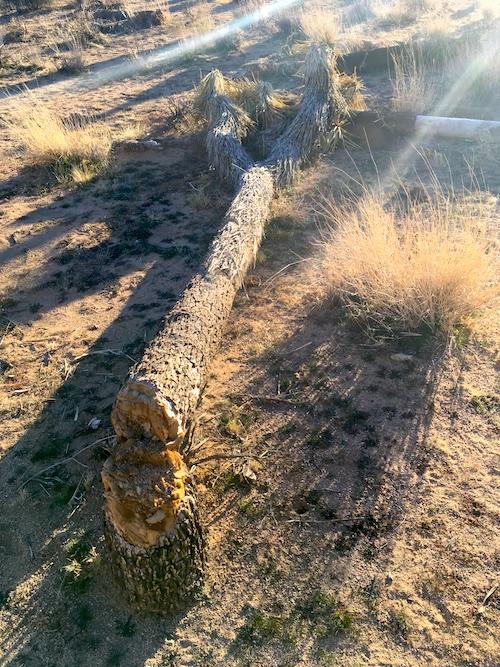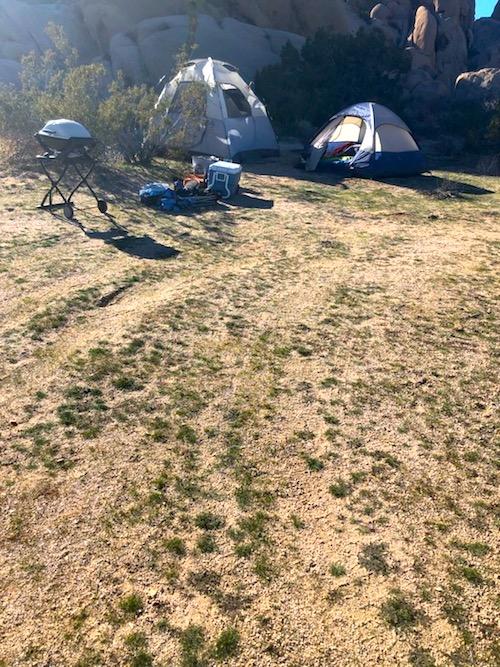
Joshua Tree National Park will close Thursday for cleanup operations/Kurt Repanshek file
Editor's note: This updates the caption of the downed Joshua tree to reflect that park officials later concluded the tree had been cut down prior to the government shutdown.
Illegal roads, cut down Joshua trees, and damaged federal property, along with the need to clean up garbage, prompted Joshua Tree National Park Superintendent David Smith to announce Tuesday that the park would close indefinitely on Thursday to address those impacts incurred during the ongoing partial government shutdown.
“The park will be closed until I can ensure that resources inside the park are protected," Smith said during a short phone call. "We’re hoping that the shutdown will be over soon."
While the closure will take effect 8 a.m. Thursday, the superintendent could not say how long it would last. Acting Interior Secretary David Bernhardt has directed the National Park Service to use fee revenues brought in under the Federal Lands Recreation Enhancement Act to pay for cleanup and additional law enforcement personnel. Smith said that while his park normally takes in about $9 million a year, most of that has been committed to projects. Staff was working to see how much in unobligated funds remained.

On February 1, just over three weeks after this story broke, Joshua Tree officials said the tree had been cut down prior to the partial government shutdown/NPS
Joshua Tree is a geologic showcase that is a climber's gymnasium, one that offers two different desert settings. Straddling the geographic divide that splits the Mojave Desert from an element of the Sonoran Desert, the park located about two hours east of Los Angeles in Southern California is both a day tripper's paradise and an adventurer's escape. The cooler winter months are the busiest in the park, which has made the task of preventing damage with a handful of rangers during the ongoing shutdown extremely difficult.
Last week park staff closed its campgrounds to overnight use because of sanitation problems, but many visitors ignored that closure. With just eight law enforcement rangers working during the partial government shutdown it was impossible to cover all areas of the park, which is about the size of Delaware.
"There are about a dozen instances of extensive vehicle traffic off roads and in some cases into wilderness," Smith replied when asked about the damage in the park. "We have two new roads that were created inside the park. We had destruction of government property with the cutting of chains and locks for people to access campgrounds. We’ve never seen this level of out-of-bounds camping. Every day use area was occupied every evening.
"Joshua trees were actually cut down in order to make new roads.”
Since the National Park Service was told to keep as many units of the National Park System open as possible during the partial government shutdown, but only with essential personnel, many have struggled with skeleton contingents of law enforcement rangers. With no maintenance crews to collect trash or maintain restrooms, and no budget to pay for outside help, many parks have been blighted by litter and human waste. There have been reports of illegal off-road travel, metal detecting on battlefields in the park system, and damage to resources.
Following Bernhardt's directive to use fee revenues, park staff across the country was busy seeing how much was available.
The new roads at Joshua Tree didn't run for miles, but rather jogged around gates to gain access in many cases, according to the superintendent.
“It’s short spurts for people to get around gates for the most part. They would just go out into the country, and then once 20 or 30 cars would go over it you would essentially have a new road created in pristine desert,” he said.

Illegal campsite in Joshua Tree National Park/NPS
One place that saw traffic was around Joshua Tree's Live Oak area, which is not far from the north entrance to the park.
“We had some pretty extensive four-wheel driving around the entire area to access probably our most significant tree in the park," Smith said. "We have this hybrid live oak tree that is deciduous. It is one of our kind of iconic trees inside the park. People were driving to it and camping under it. Through the virgin desert to get to this location. That would probably be a quarter-mile or so around the rock formation that is there.”
The superintendent said there also were instances of graffiti in the park this past week. Park officials were identifying additional staff and resources needed to address immediate maintenance and sanitation issues.
Monitoring a park the size of Joshua Tree, which covers 1,235 square miles and has about 20 different entrances due to dirt roads that ring the park, is extremely difficult with just eight law enforcement rangers. Were it not for the shutdown, there would have been more than 100 other "sets of eyes" to help keep an eye on visitor behavior, the superintendent said.
"We have 120 employees in the park, plus 30 associates that work for Great Basin Institute, the majority of whom are in the park every day," he said. "Those are the folks that are in the campgrounds and in the day-use areas and doing science. So you’ve got 100 sets of eyes in the park every day with folks contacting visitors."
Law enforcement rangers were to continue to patrol the park and enforce the closure until park staff completes the necessary cleanup and park protection measures.
If you appreciate this coverage of the National Park System, please consider a donation to National Parks Traveler, a 501(c)(3) nonprofit media organization dedicated to covering national parks and protected areas. Your support enables us to send writers and photographers out into the parks to provide this coverage for you.



Comments
To y_p_w
I've been to over 40 natl parks in the West (mostly) and I have yet to see any NP regulation/policy to allow picking up firewood. Period! Perhaps you should get aquainted with the policies. You must be confusing with prov parks in Canada > totally different set up and rules.
Way to go, "Knowingness". The first day you arrive in the neighborhood you start off by challenging the ethics of the publisher and founder of our little website.
That tree was ot cut down . That is a dead rotten tree trunk. Definitely not a newly fresh cut tree . And not cut down to gain access to the area . Can easily drive around it. No tire marks on ground . More fake news for suckers
Wild Places--
"Essential Personnel" are determined by guidance from OMB and DOI, with park-specific plans approved and in place before any individual shutdown. Basically, a few LE rangers are essential personnel, under the safeguard human life and protect resources (vandalism) exception. And a skeleton of the chain of command (a couple per region) are declared essential so that they can spread the word after a shutdown ends, and possibly respond to unforeseen events. No one in basic park operations can be labelled essential: not facilities staff doing restrooms, trash, etc., nor VUAs collecting entrance fees, nor interp rangers interacting with the public. But also, no one involved with the "unimpaired for the enjoyment of future generations" mandate is essential when it comes to furlough: not the folks actually doing vegetation or wildlife management, not the science folks helping inform long-term resource management. Those are the rules on essential persnnel; the order was then given to keep the parks open as much as possible with only those personnel. [Parks that close gates or doors at night are still to remain closed for the duration of the shutdown: again, not the superintendent's call.] If essential vs non-essential was determined by what has to happen immediately to meet the NPS mission vs what can be delayed until the government is funded, a very different mix of personnel would be considered essential.
I know of one park superintendent who is fighting to get some natural resource staff declared essential to prevent long-term or permanent degradation of specific park resources independent of whether there are visitors in the park, and there's another superintendent I sure hope will step up and at least make that argument. I doubt that they'll succeed (unless the shutdown lasts several more months), but I think that argument needs to be put down in writing, and we need to see how far up the chain it goes (NPS region, NPS WASO, DOI, OMB/OPM).
One tree is all we need then what two trees and then your town and then the city and u would be like well its just that city. They were hillary supporters anyway. #fool
To think this would normally occur with a fully staffed park, it's just niave. democrats and republicans have funded the government, it's the president who's throwing a temper tantrum because he isn't getting his way. you can't just shut down a government because someone isn't getting their way, that's not how democracy works. that would be an oligarchy
except there isnt a wall surrounding the entire park and no one is suggesting that as a solution to solve the vandalism. Plus people are going around the man made barriers in place without supervision of the park showing that these types of barriers are ineffective And easily deterred. Monitoring entry points and proper surveillance work under normal operations of a park to keep it clean.
Sad that there are those who value nothing, respect nothing an give nothing to society.